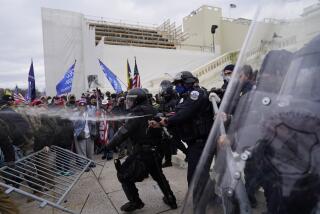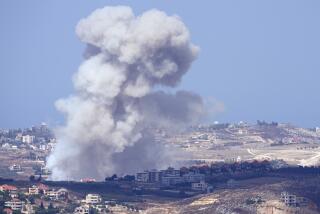Conventional Terrorism Still Works
- Share via
WASHINGTON — Five bombings in four weeks. The targets: a downtown shopping mall, a military housing complex and three apartment buildings. The victims: civilians or the families of serving military personnel either asleep in their beds or out window-shopping on a pleasant summer day. The death toll: at least 350 persons, with scores more injured and maimed. The perpetrators: unknown. The reason for the attacks: unclear. Welcome to terrorism, 21st century-style.
At a time when the United States is obsessed with more exotic threats like bioterror, cyberterror and agroterror, these incidents in Russia and Dagestan underscore how terrorists can still achieve their dual aim of fear and intimidation through conventional means and traditional methods: using bombs to blow things up. This has important implications for U.S. counterterrorism preparedness. As fanatical and irrational as terrorists often appear, they remain remarkably conservative operationally, adhering to the same uncomplicated weapons and tactics upon which they have relied for more than a century.
In other respects, too, the string of deadly explosions that has convulsed Russia and attracted worldwide attention is not without precedent. Nor can it be written off as some isolated phenomenon, inspired by recondite historical enmities and emanating from an obscure corner of the globe. Rather, the bombings conform to a pattern of terrorism evident throughout the 1990s: The most heinous and lethal attacks, those directed against civilians, go unclaimed.
This development is in marked contrast to the modus operandi of the first generation of modern terrorists who surfaced during the 1970s and 1980s. They not only proudly claimed credit for particularly bloody attacks, but generally issued detailed, overwrought and overwritten communiques explaining precisely why they had carried out their operations. With few exceptions, the vast majority of terrorist incidents perpetrated between 1969-89 and that produced large casualties were all claimed. For example, the series of suicide bombings carried out against U.S. diplomatic and military targets in Lebanon, and in Kuwait during 1983 and 1984, causing nearly 400 deaths, were claimed by Islamic Jihad.
True, a large number of terrorist attacks have gone unclaimed. According to a Rand report published in 1985, upward of 60% of international terrorist incidents recorded between 1980-82, and 39% of those that occurred in the 1970s, were never claimed. But significant as these percentages may be in the aggregate, they apply more to garden-variety terrorism than to the still relatively rare terrorist “spectaculars,” the dramatic, attention-riveting, highly lethal acts that so effectively capture the attention of both the media and public alike, such as the recent incidents in Russia.
The most deadly terrorist incidents of the 1990s have never been credibly claimed, much less “explained” or “justified” as terrorist acts once were. Among these are: the series of car and truck bombings that rocked Bombay in 1993, killing 317 persons; the huge truck bomb that destroyed a Jewish community center in Buenos Aires in 1994, killing 86; the truck bomb that demolished the Alfred P. Murrah Federal Building in Oklahoma City, leaving 168 dead in 1995; the series of bombings in Paris that occurred the same year between July and October and left eight dead and 200 wounded; and last summer’s bombings of the U.S. embassies in Kenya and Tanzania, in which 224 persons perished and thousands more were wounded. The 1988 in-flight bombing of Pan Am 103, in which 270 persons perished, is an especially notorious example. Although two alleged Libyan government intelligence operatives were identified and accused of placing the suitcase containing the bomb that eventually found its way onto the plane, no believable claim of responsibility has ever been issued. The two are about to stand trial in The Hague.
That terrorists today do not feel as driven to take credit for their acts may be related to their belief that their message, whatever it may be, is still “reaching” its intended audience. As the renowned terrorism expert Walter Laqueur has observed, “If terrorism is propaganda by the deed, the success of a terrorist campaign depends decisively on the amount of publicity it receives.” In this respect, terrorists are still getting all the publicity they crave, but they are manipulating and exploiting it in different ways.
By maintaining their anonymity, terrorists may believe they are better able to capitalize on the fear and alarm intrinsically generated by their violence. Attacks perpetrated by enigmatic, unseen and unknown assailants may thus be deliberately designed to foment greater insecurity and panic in the target audience. In this way, the terrorists’ ability to portray themselves as being able to strike whenever and wherever they please, while highlighting the government’s inability to protect potential targets, is appreciably heightened. The terrorists are seen to appear stronger, the government weak and powerless to stop the mayhem.
Terrorists have long sought to embarrass governments and undermine public confidence in their leaders. Even when they issue no claim, the perpetrators may believe they are still effectively “harming” their enemy and achieving their ultimate objective. They may also be confident that even if their message is not clearly understood, the suspicion aroused by even an anonymous attack is sufficient reward in itself, as well as having the added advantage of possibly delaying or blunting military retaliation.
The current situation in Russia illuminates the challenges faced by other countries confronted with terrorist threats. The potentially corrosive effects of fear and uncertainty on civil liberties and constitutional safeguards are already evident: Russian authorities and the Russian public have singled out Chechen, Dagestani, Ingushetian and other swarthy, dark-haired immigrants from the Caucasus. Discriminated against in the best of times, they have been subjected to withering scrutiny despite assurances from President Boris N. Yeltsin and other senior officials that no one ethnic group or people would be targeted for attention. To date, some 11,000 persons have been detained by Russian police. Few of them have been accused of any terrorist offenses. The vast majority have been held on charges ranging from possessing improper identity documents to petty thievery.
The ease with which Russia has been thrown into panic by a handful of men using entirely conventional terrorist weapons and tactics suggests that terrorists can still ably achieve their objectives of fear and intimidation without having to resort to more exotic weaponry or futuristic tactics. This is an important lesson for the United States, where the focus of current counterterrorism efforts has been on low-probability/high-consequence terrorist incidents using weapons of mass of destruction. Attention on this high-end threat, therefore, should not be at the expense of more high-probability/lower-consequence incidents, such as ordinary terrorist bombings.
The United States must be confident that its defenses and preparations are capable of responding not just to the big-budget threats prophesied by thriller writers and government officials, but also to the low-end attacks that cause the same strains and unleash the same forces of suspicion and intolerance in societies everywhere *
More to Read
Sign up for Essential California
The most important California stories and recommendations in your inbox every morning.
You may occasionally receive promotional content from the Los Angeles Times.










